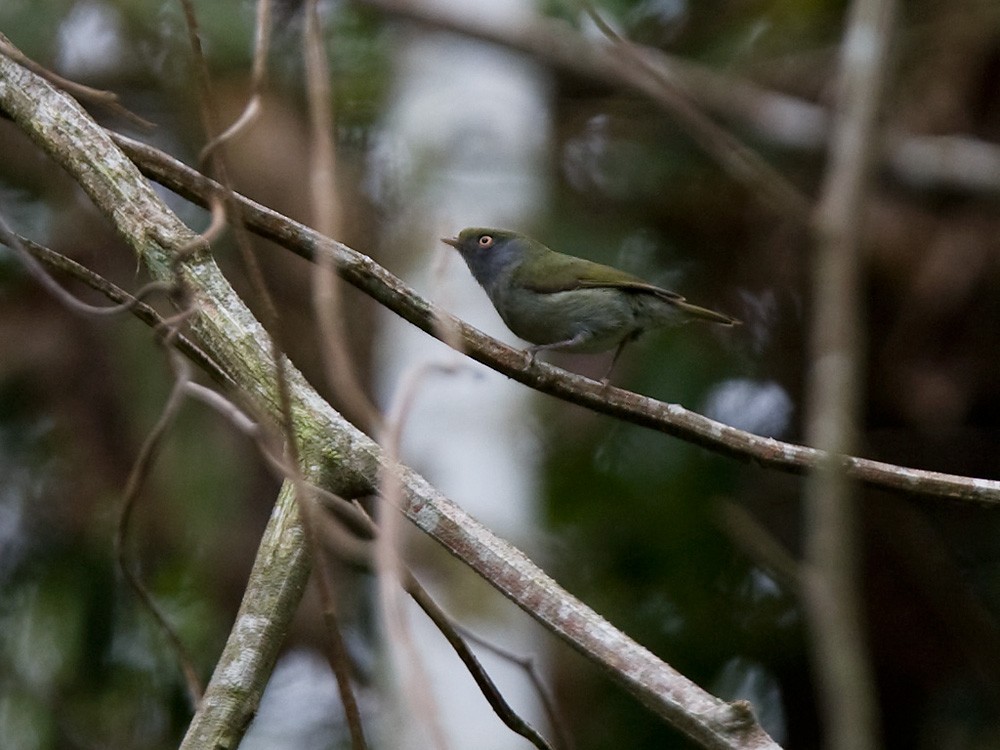Pin-tailed Manakin
A species of Pin-tailed Manakin Scientific name : Ilicura militaris Genus : Pin-tailed Manakin
Pin-tailed Manakin, A species of Pin-tailed Manakin
Botanical name: Ilicura militaris
Genus: Pin-tailed Manakin
Content
Description General Info
 Photo By Lars Petersson
Photo By Lars Petersson Description
Males measure 12.5 cm (4.9 in), while the females measure 11 cm (4.3 in) from tail to beak at full maturity. There is clear sexual dimorphism between mature adults of this species, but can be nearly impossible to identify the sex for certain if they do not have the adult male colorations, as both juvenile males and females resemble each other. All pin-tailed manakins share some common traits: a forking tail at the very end of their rectrices, a slightly elongated forehead, brownish black legs, and bright yellow-orange irises. Adult male pin-tailed manakins have a slightly longer tail, with a very uniquely pigmented red fore-crown and rump, black wings with green secondaries, and a white chest that extends from their under-tail coverts all the way to their auriculars. Females are an olive-green color everywhere except for their grey neck and auriculars, and their crème colored chest extending to its under-tail coverts 
Size
11 - 12 cm
Nest Placement
Tree
Feeding Habits
Pin-tailed Manakin primarily consume small berries, particularly from yellow magnolia and chickweed plants, occasionally adding insects to their diet. They forage mainly at forest edges, using aerial maneuvers to snatch food. Distinctively, pin-tailed Manakin consume their food whole without picking at plants.
Habitat
The habitat of pin-tailed Manakin encompasses humid forests and well-developed secondary woodlands. These birds are typically associated with montane regions in the northern part of their range, while in the southern areas, they extend to lowland forests, residing from the foothills to adjacent flatlands. Their preference includes areas with dense vegetation and a high degree of natural forest cover.
Dite type
Insectivorous
General Info
Feeding Habits
Bird food type
Distribution Area
The pin-tailed manakin is endemic to Brazil, specifically inhabiting the Atlantic Forest range from the State of Bahia to the State of Rio Grande Do Sul. Its natural habitats are subtropical or tropical moist lowland forests and subtropical or tropical moist montane forests. They are not very commonly spotted within their range, but spend their time within the lower and middle strata of the rainforests. Their nests are built very similar to a cup, and holds a clutch of 2 to 3 eggs. Their distribution has not been studied in depth, and as a result there is not a firm grasp of where their populations may inhabit. Three pin-tailed manakins have been collected by the Museu Nacional in Rio de Janeiro that has their location of collection tagged as Nova Veneza, which is more inland and Northern than previously recorded, providing evidence for a possible extension of their range. 
Species Status
The pin-tailed manakin is not globally threatened, but is uncommon to fairly uncommon within the Atlantic Forest range of Brazil. According to the IUCN, the pin-tailed manakin is rated as Least Concern with an unknown quantity of individuals, suspected to be in decline from habitat destruction, but needs more research conducted to provide an accurate conservational account. 

 Photo By Lars Petersson
Photo By Lars Petersson Scientific Classification
Phylum
Chordates Class
Birds Order
Perching birds Family
Manakins Genus
Pin-tailed Manakin Species
Pin-tailed Manakin